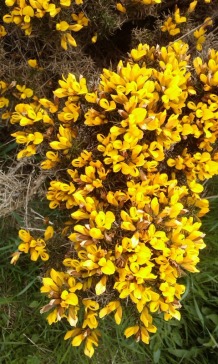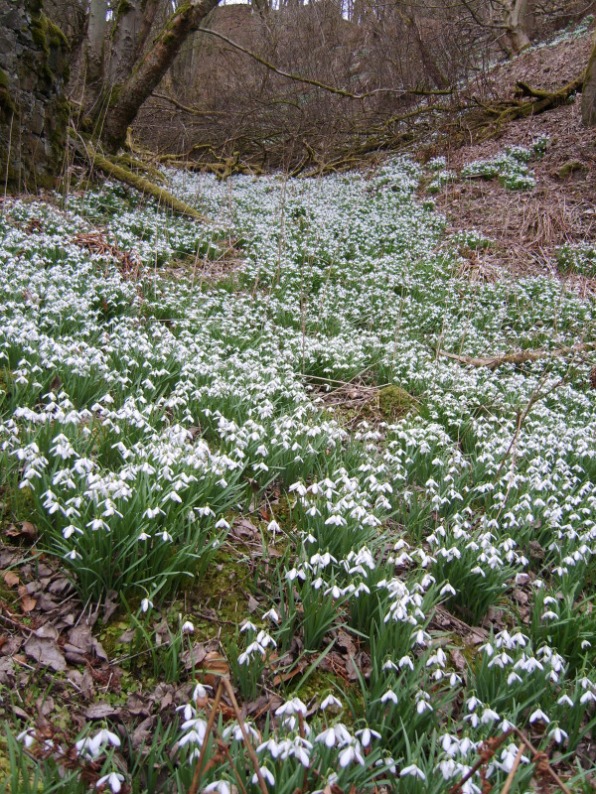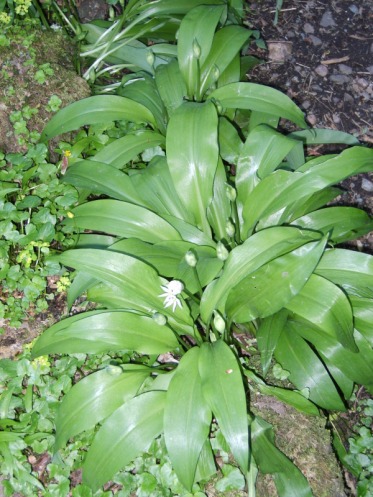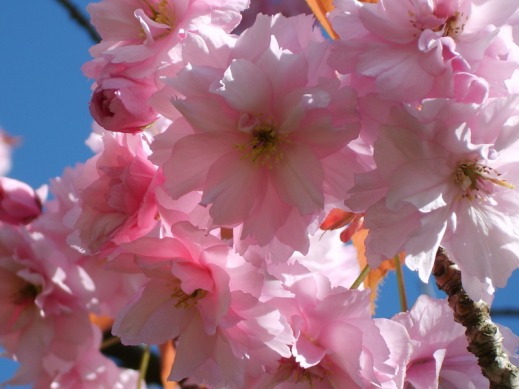A very Brief introduction to some of the highlights of the local plant-life
The time for Lovers is when the Gorse is in bloom

There are a number of varieties of Gorse, usually one of them will be in bloom at any given time of the year, hence the expression.
Somehow I always associate Gorse with Scotland, and it is certainly plentiful here.
It is the emblem of the Sinclair and McLellan families.
The plant (Ulex) is a member of the Pea family (Fabaceae) and the beautiful flowers are edible, and sometimes used to make tea or wine.
The plant can be mashed with mallets and used as animal fodder, indeed some wintering feral ponies can survive on just eating Gorse.
Some people notice the coconut like smell, and apparently some are less sensitive to it.
Somehow I always associate Gorse with Scotland, and it is certainly plentiful here.
It is the emblem of the Sinclair and McLellan families.
The plant (Ulex) is a member of the Pea family (Fabaceae) and the beautiful flowers are edible, and sometimes used to make tea or wine.
The plant can be mashed with mallets and used as animal fodder, indeed some wintering feral ponies can survive on just eating Gorse.
Some people notice the coconut like smell, and apparently some are less sensitive to it.
Snowdrop Valley

The Plant Observer's year would most often begin with the cheering Snowdrops coming into bloom, perhaps even peeking through the Snow.
This shot was taken at a forgotten place known as "Snowdrop Valley".
The valley was known to me many years ago, but it was a very long time since I visited this secluded spot near the River Devon just below Rumbling Bridge.
Nobody seemed to know any more where it was - or even if the beautiful large snowdrops still bloomed there.
A couple of local ladies who lived there denied all knowledge, and said there was no such place, but then the area has been built up and access is not obvious any more.
I was delighted to see the Snowdrops in their full splendour. A real treat, and brought back many memories. Even my Mother and Father used to go there courting.
Snowdrops are part of the Amaryllis family and thought to have been introduced to Britain around the 16th Century.
The are called "Galanthos" from the Greek words Gala (for Milk) and Anthos (Flower)
This shot was taken at a forgotten place known as "Snowdrop Valley".
The valley was known to me many years ago, but it was a very long time since I visited this secluded spot near the River Devon just below Rumbling Bridge.
Nobody seemed to know any more where it was - or even if the beautiful large snowdrops still bloomed there.
A couple of local ladies who lived there denied all knowledge, and said there was no such place, but then the area has been built up and access is not obvious any more.
I was delighted to see the Snowdrops in their full splendour. A real treat, and brought back many memories. Even my Mother and Father used to go there courting.
Snowdrops are part of the Amaryllis family and thought to have been introduced to Britain around the 16th Century.
The are called "Galanthos" from the Greek words Gala (for Milk) and Anthos (Flower)
Wild Garlic

Wild Garlic is probably the first edible plant I would be looking for in the Spring.
Garlic is known as a "Superfood" and is very healthy to eat.
Roman Soldiers were apparently partially paid with Garlic Cloves, I believe something like one per day per man (perhaps)
Cultivated garlic is known as Allium Sativum, it is a member of the Onion family.
Generally the bulbs are eaten, but the stalks and flowers are also edible, and less bitter. Garlic sweetens with cooking, and if you have never tried roasted garlic, then add a few cloves to your Sunday Roast, I have used a recipe that called for 40 cloves of garlic to be used as a bed for a chicken, the flavour went through the chicken and the garlic itself was quite delicious.
Garlic has anti-bacterial, anti-fungal and anti-viral properties. It is also supposed to reduce cholesterol build up, though this has not been scientifically verified. Garlic can help to regulate blood sugar levels.
Garlic contains certain amounts of all the amino acids and a good deal of minerals too, including Selenium which is often deficient in modern diets, so it may help fight depression.
Garlic is known as a "Superfood" and is very healthy to eat.
Roman Soldiers were apparently partially paid with Garlic Cloves, I believe something like one per day per man (perhaps)
Cultivated garlic is known as Allium Sativum, it is a member of the Onion family.
Generally the bulbs are eaten, but the stalks and flowers are also edible, and less bitter. Garlic sweetens with cooking, and if you have never tried roasted garlic, then add a few cloves to your Sunday Roast, I have used a recipe that called for 40 cloves of garlic to be used as a bed for a chicken, the flavour went through the chicken and the garlic itself was quite delicious.
Garlic has anti-bacterial, anti-fungal and anti-viral properties. It is also supposed to reduce cholesterol build up, though this has not been scientifically verified. Garlic can help to regulate blood sugar levels.
Garlic contains certain amounts of all the amino acids and a good deal of minerals too, including Selenium which is often deficient in modern diets, so it may help fight depression.
Cherry Blossom

I think Cherry Blossom is one of the most beautiful of the ephemeral spring blooms.
I heard a story of a man who was forced out of his house during the war by the invading Japanese army. All the other local houses were destroyed, but his was not, seemingly the reasoning was simply that he had lots of Cherry Trees in his garden and they were so loved by the Japanese that they left his house and garden intact.
The Cherry is a member of the 'Prunus' family, which includes Plums, Apricots and Peaches.
Apparently they were brought to Britain by Henry VIII who first tried them in France..
Seemingly Cherries contain good amounts of antioxidants.
I heard a story of a man who was forced out of his house during the war by the invading Japanese army. All the other local houses were destroyed, but his was not, seemingly the reasoning was simply that he had lots of Cherry Trees in his garden and they were so loved by the Japanese that they left his house and garden intact.
The Cherry is a member of the 'Prunus' family, which includes Plums, Apricots and Peaches.
Apparently they were brought to Britain by Henry VIII who first tried them in France..
Seemingly Cherries contain good amounts of antioxidants.
